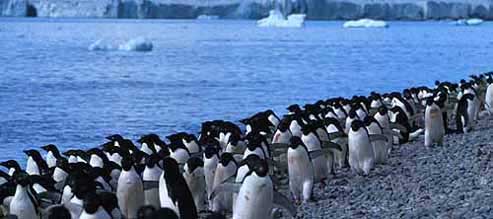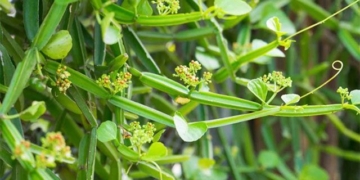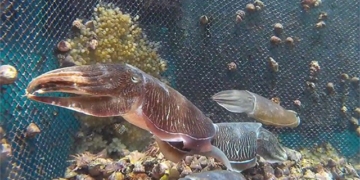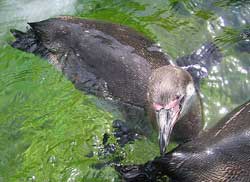 Typically, people think that penguins live in cold places like Antarctica, but there is a species known as the Humboldt penguin that resides in warmer regions. This penguin is named after the Humboldt Current (a cold ocean current of the South Pacific that flows northward along the western coast of South America). The scientific name of the Humboldt penguin is Spheniscus humboldti.
Typically, people think that penguins live in cold places like Antarctica, but there is a species known as the Humboldt penguin that resides in warmer regions. This penguin is named after the Humboldt Current (a cold ocean current of the South Pacific that flows northward along the western coast of South America). The scientific name of the Humboldt penguin is Spheniscus humboldti.
Humboldt penguins primarily hunt fish (about 30 species of small schooling fish), as well as marine invertebrates (some species of squid) and crustaceans. Their diet changes with the seasons, and due to unique glands in their bodies, Humboldt penguins can easily excrete excess salt from consuming seawater and marine animals. With swimming speeds ranging from 18 to 26 miles per hour, they can effortlessly pursue and catch small fish.
Usually, they dive to depths of 60 to 80 meters in search of food and surface to breathe after 2 to 3 minutes underwater. However, penguins that are raising young can dive as deep as 150 meters to gather enough food.
At the end of each breeding season, parent penguins head out to sea to forage for a long period, eating voraciously and becoming the plumpest they are all year. When they return to shore, their body weight can double, making them so bulky that they must crawl up the beach rather than walk. Afterwards, Humboldt penguins will undergo a molting process that lasts several weeks, during which they refrain from eating, resulting in a loss of up to half their weight. During molting, they have limited contact with cold water because their bodies are no longer well insulated. During this time, they easily become prey for many predators, as their energy reserves are depleted, and their feathers are not in optimal condition for swift movement in water.
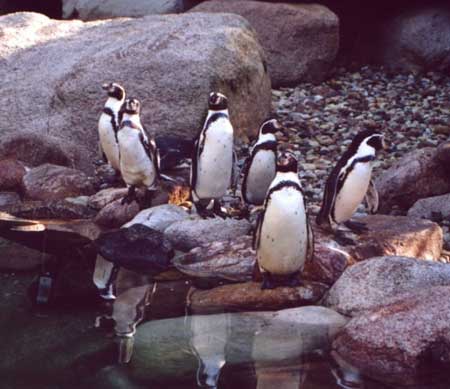
This warm-weather penguin is quite recognizable: Their faces are black and white, with a black upper body and a white belly that aids in camouflage. From below, their white bellies make them hard to spot due to the dim light filtering through the water; from above, their black backs blend with the dark depths, making them less detectable.
Humboldt penguins have a gland located near their tails that secretes oil, which they use to coat their feathers, keeping them waterproof. Their plumage becomes ragged after a year and is replaced after the breeding season. Although they cannot fly in the air, penguins can “fly” underwater. They swim using their wings, and their webbed feet are used for steering. Their rigid skeleton allows them to dive deep while hunting; their beaks have razor-sharp edges.
 On average, they stand about 60 cm tall and weigh between 3 to 5 kg, with females being slightly smaller than males. In human care, they can live over 30 years.
On average, they stand about 60 cm tall and weigh between 3 to 5 kg, with females being slightly smaller than males. In human care, they can live over 30 years.
Humboldt penguins often live in large colonies. When moving on land, they typically walk in single file; one follows the other in a long line.
The coastal areas where Humboldt penguins reside are susceptible to the El Niño Southern Oscillation (ENSO), which often causes extreme food shortages. During such times, the nutrient-rich, cool currents along the coasts of Chile and Peru are replaced by warmer, nutrient-poor waters from the central Pacific. These less nutritious waters significantly reduce the availability of phytoplankton, directly impacting the entire food chain. As apex predators in this food chain, Humboldt penguins are among the species most severely affected, often facing the risk of starvation. When ENSO events occur, the weather can be erratic, bringing heavy rains and flooding. The nests of Humboldt penguins can be washed away by rising waters.
Humboldt penguins also face drowning due to entanglement in fishing nets. Various predators pose further threats to their survival.
Nests of Humboldt penguins are primarily found on offshore islands of Peru and Chile. They often burrow into dry guano piles to shelter themselves, their eggs, and their chicks from the sun and predators. Guano is a valuable fertilizer in agriculture and is often harvested clean by exploiters.
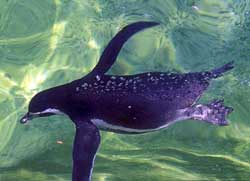 The large-scale hunting of Humboldt penguins at their breeding sites is also one of the main reasons for the rapid decline of this species in many areas. Their food sources have diminished due to fishing activities. Consequently, their population has plummeted from hundreds of thousands in the mid-19th century to only a few thousand today.
The large-scale hunting of Humboldt penguins at their breeding sites is also one of the main reasons for the rapid decline of this species in many areas. Their food sources have diminished due to fishing activities. Consequently, their population has plummeted from hundreds of thousands in the mid-19th century to only a few thousand today.
Humboldt penguins begin breeding at around 2 years of age and mate for life. Females lay two eggs at a time. The incubation period lasts about 6 weeks, with both the male and female participating in the incubation.
Chicks feed on regurgitated food from their parents, who go out to sea to forage for their young from early morning and return to the nest by evening. The duration of foraging trips increases as the chicks grow and require more food. Humboldt penguins rarely venture more than 35 km from their nesting sites while foraging, but they may migrate several hundred kilometers during winter before returning to breed again.
Typically, only one chick survives per brood. The chicks leave the nest about a month after hatching when they are capable of entering the water. After 10 to 12 weeks, once they have developed sufficient feathers, the young will depart from their birthplace. They then spend several months out at sea foraging.
